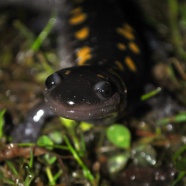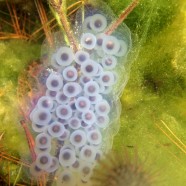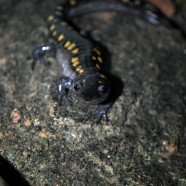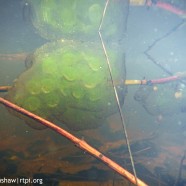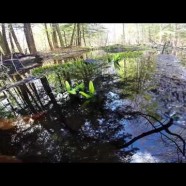Will the Big Night be Coming Soon?
Have you seen any signs of spring yet? We certainly have! Robins are actively feeding, red-winged blackbirds are beginning to sing, and it won’t be long before our resident salamanders come out from their winter refuges. Conditions have to be just right to entice them out from under their chosen cover objects; a warm 40° night with rain sets the stage for spotted salamanders to begin their migration. Will we soon see the required circumstances to set this charismatic species on the move? Keep an eye on the weather and another on nearby pools and ponds so as not to miss the big...
Read MoreDo you know your amphibian egg masses?
Despite the snow, the internal clocks of many amphibians are already set to spring. As a result, a number of them have already journeyed from the safety of their winter refuges to nearby pools and ponds to breed and deposit their eggs. This past Friday, prior to the weekend storm, I spent time exploring some local water bodies and found a plethora of these kinds of eggs. Any idea of what these little eggs will eventually turn into? I’ll give you a hint, the bottom picture shows both eggs and spermatophores. If you guessed Spotted Salamander (Ambystoma maculatum), you would be correct!...
Read MoreCould it Be That Time Already?!
Our winter weather has been getting stranger by the day! This week we are going to see daytime temperatures in the mid 60’s and overnight temps in the low 40’s and 50’s with possible rain. And you know what that could mean right? Amphibians could potentially begin their migrations to their vernal breeding pools within the next few days! This time last year we were still buried in snow and were still experiencing some of the winds and weather from the “polar vortex.” Due to the extreme cold last year, it wasn’t until early April when we saw spotted...
Read MoreBouncing Babies
Here we have some bouncing baby…umm, boys and girls I would guess. These spotted salamander (Ambystoma maculatum) babies will soon be hatching from their globular masses and become veracious predators in the little vernal pools in which they temporarily reside. As they feed and grow, they will be racing against the clock in order to develop from free swimming legless tadpoles into four legged land dwellers before their nursery pool dries out towards the end of the summer. Talk about rapid development! Elyse Henshaw Conservation Technician
Read MoreProductive Vernal Pools
Have you ever wondered what might be hiding just beneath the water’s surface in these temporary pools that crop up in early spring? This little clip reveals a productive vernal pool that has a number of spotted salamander (Ambystoma maculatum) egg masses nestled within the leaf litter of the pool floor. These pools are an important breeding area for several amphibian species, as you can see, because they provide a safe fish-less environment for the eggs and eventual tadpoles to...
Read More



